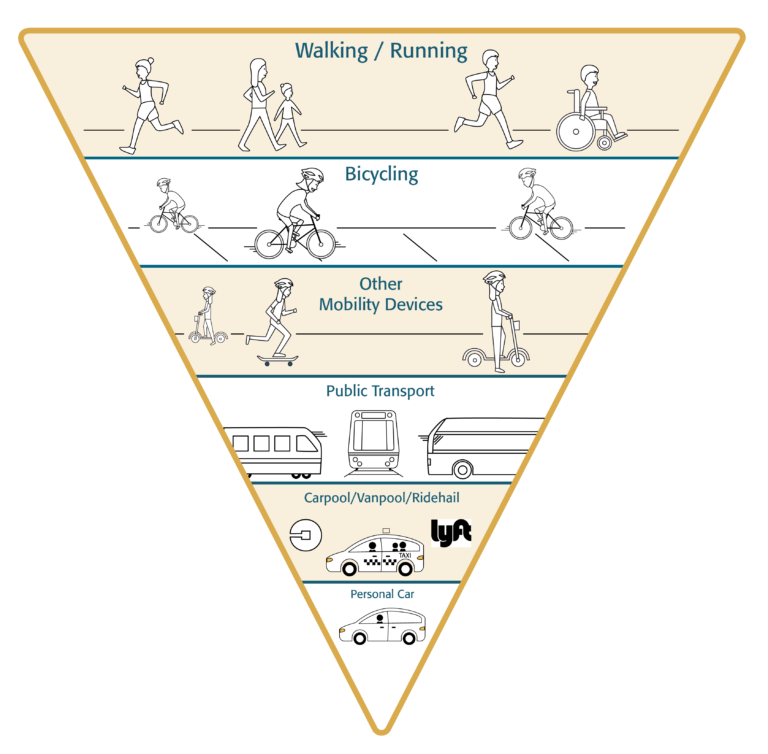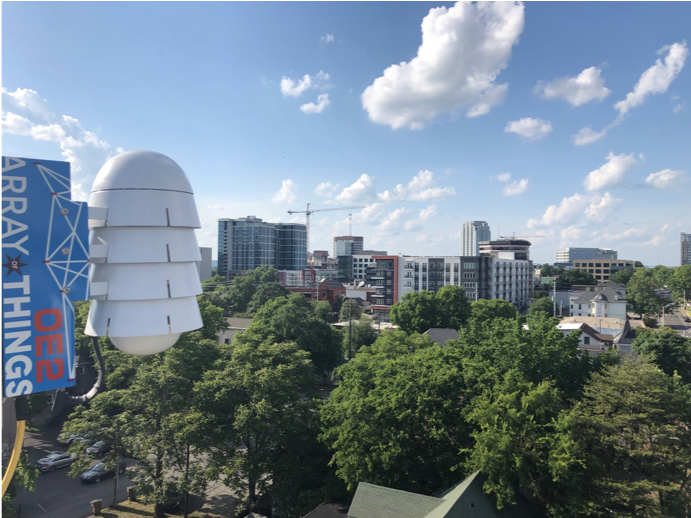Vision and Goals
MoveVU Vision
On Earth Day 2019, Vanderbilt University committed to achieving carbon neutrality by 2050. In 2019, about a quarter of Vanderbilt’s carbon footprint was produced by faculty, staff, and students commuting to campus in single occupancy vehicles.
The vision of MoveVU, the university’s strategic transportation and mobility plan, calls for a transformation in how the Vanderbilt community commutes to campus – one with less reliance on single occupancy vehicles and less demand for parking – by offering a “daily decision” of travel mode choice. In pursuit of the MoveVU goals, the Transportation & Mobility Office was created in 2018 to coordinate strategic transportation infrastructure planning and to implement a comprehensive Transportation Demand Management (TDM) program.
MoveVU Programs
A Comprehensive Transportation Demand Management (TDM) Program
Since the MoveVU plan was initially published, the Transportation & Mobility Office has prioritized three core programs related to parking and commute behaviors as part of a comprehensive TDM program:
Launched in February 2020, the Commute Hub provides a website and mobile app that helps commuters track their trips and connect to other carpoolers and vanpoolers.
Daily parking was introduced in September 2020. The daily parking program currently has over 3,500 community members participating. Historically, all university parking permits were purchased annually. Rather than paying a flat annual fee, which provides unlimited parking access across the year, parkers in the daily parking program only pay for days that they park on campus, increasing the financial motivation associated with considering other modes on any given day. Users can see their parking deductions and receive statements that summarize their trips and parking charges in the MoveVU Commute Hub and app.
Incentive payments for active and carpool commutes launched in September 2021. Commuters who take a commute such as carpooling, vanpooling, walking, biking, or riding the bus will receive an incentive payment. These incentives are applied to faculty and staff’s paychecks and graduate and professional students’ Commodore Card.

Vanderbilt’s comprehensive TDM program also provides commuter benefits, including transit passes that allow all students, faculty and staff to ride WeGo Local and Regional service for free, a guaranteed ride home program and access to commute planning assistance from a commute concierge.
Visit our Programs and Benefits page for a full list of MoveVU programs.
MoveVU Commute Data
One of MoveVU’s goals is to shift the university’s mode share to increase the number of commuters taking active and carpool/vanpool commute modes and decrease the number of commuters driving single occupancy vehicles.
The Transportation & Mobility Office, in partnership with the Office of Data & Strategic Analytics (DSA) conducts an annual survey to determine the commute and transportation practices of the university community. The survey results help inform mobility and transportation efforts and expand Vanderbilt’s understanding and support of the community.
Learn more about the commute survey results from 2019, 2022, 2023 and 2024.
Walking & Biking
The university plans to develop a greenway network, building off the greenway concept foundational to FutureVU, throughout campus and a Walk and Roll Loop around the campus edge. This comprehensive, layered and connected mobility ecosystem is aimed at connecting neighborhoods, making campus more pedestrian- and bicycle-friendly and opening the campus edge to the surrounding community.
Pedestrian Safety
In Nashville, like many U.S. cities, pedestrians may have to navigate streets that don’t yet have sidewalks, lighting or crosswalks.
Here are some recent example of projects Vanderbilt has implemented to increase pedestrian safety on and around campus.
The re-imagination of the West End neighborhood transformed it to a more park-like feel and community atmosphere. The goal was to beautify, enhance and make more inclusive and accessible the West End Neighborhood, as well as create spaces for student-led gatherings and events.
Studies have shown that almost half of fatal pedestrian crashes occur after dark, on streets with little or no street lighting. Vanderbilt installed a special enhanced crosswalk with push button lights on 25th Avenue and Kensington. It was the first of its kind in Nashville—now you can find installations of similar crosswalks in more locations throughout the city.
The Walk and Roll Loop will be a wide and comfortable loop encircling campus that promotes active transportation and recreation and will connect Vanderbilt with the surrounding city. Many parts of the loop already are complete, such as by Kissam Center, Owen Graduate School of Management and Zeppos College.
Crafting the MoveVU Vision (2016-2018)
Foundation of strategic planning
The evolution of the MoveVU Plan first began in November 2015, with the launch of FutureVU. FutureVU began as a comprehensive land use planning effort and since then has evolved into an holistic planning process focused on developing the spaces on campus and investing in the initiatives that support the people who live, work and learn in them. FutureVU continues to be driven by and embodies the university’s core values and holistic approach to Vanderbilt’s teaching, research and service mission. As part of the FutureVU process, Chancellor Emeritus Nicholas S. Zeppos and Vice Chancellor for Administration Eric Kopstain held a town hall meeting with the VU community in late October 2016 to discuss transportation and mobility, which are key enablers to realizing the FutureVU vision. They also invited members of the VU community to participate in a series of working groups comprised of students, faculty, and staff.
More than ninety individuals (faculty, staff and students) signed up to participate in the Transportation Working Groups. Six working groups were convened and met regularly from November 2016 throughout the spring semester of 2017.
The working groups were tasked with identifying mobility and transportation strategies for the university in the following areas:
- Metropolitan Transit Authority / Regional Transportation Authority (MTA/RTA) bus and train adjustments to better service Vanderbilt
- Vanderbilt shuttle opportunities
- Expansion of Uber and Lyft opportunities on campus
- Expansion of on-campus biking infrastructure and bike programs
- Potential alternative work arrangements
- Vanpools, carpools and other partnerships
Each working group was led by a VU faculty and/or staff member and resulted in the submission of recommendations at the end of April 2017.
MoveVU collaboration
The MoveVU Implementation Plan was built through a unique collaborative process with faculty, administrators, students, and staff throughout 2018. In May 2018, a consultant team was chosen, and a Working Group was convened to assist with scoping, guiding, and informing the MoveVU Plan process.
This began a seven-month process of close collaboration and engagement with a variety of Vanderbilt stakeholders with the objective of identifying synergies between current and ongoing initiatives and MoveVU Plan development. Strategic collaboration was meant to ensure that MoveVU properly advances the previous work completed, including the recommendations from the FutureVU Transportation Working Groups, and develops strategies that meet additional university initiatives. A summary of the stakeholder collaboration conducted as part of the process is included below.
Collaboration with faculty leaders was a central part of the MoveVU Implementation Plan process. Mark Abkowitz, Craig Philip, Dan Work, and other faculty members were integral to the process. These talented faculty members enriched the process with the knowledge they brought through their involvement in Vanderbilt’s successful Congestion Mitigation and Air Quality (CMAQ) grant application, and their ongoing work leveraging big data to understand and improve transportation experiences at Vanderbilt and beyond.
Understanding the perspective, challenges, and desires of Vanderbilt students related to parking, transportation, and accessibility was a key element of the MoveVU Implementation Plan. The project team met with members of the Dean of Students team, as well as members of the Vanderbilt Student Government throughout the process. The university is committed to expanding mobility options for students to travel around campus and to and from destinations off-campus.
The project team held several strategic planning meetings with regional stakeholders throughout the MoveVU Implementation Plan process, including the Tennessee Department of Transportation, Metro Nashville Planning and Public Works, and the Nashville Metropolitan Transit Authority. The purpose of these meetings was to update regional stakeholders on the goals and process of the MoveVU Implementation Plan, learn about ongoing transportation initiatives in the region, and identify opportunities for synergy where the city and Vanderbilt University can work together to achieve common multi-modal mobility, accessibility, and congestion mitigation goals.
An important milestone in the MoveVU Implementation Plan process was the FutureVU Mobility Expo held on November 6 at the Wond’ry. The event was hosted by the Division of Administration and included appearances by Chancellor Emeritus Nicholas S. Zeppos, former Tennessee Department of Transportation Commissioner John Schroer, and Vice Chancellor for Administration Eric Kopstain. The Mobility Expo included information from WeGo, bike and scooter safety information, a display on transportation research conducted by Vanderbilt faculty, information about ongoing campus sustainability and building projects, and the public launch of the MoveVU Implementation Plan.

These efforts align with FutureVU Guiding Principles of:
- Prioritizing campus land for academic and residential buildings and green and community space
- Preserving Vanderbilt’s park-like setting
- Promoting the walkability and sustainability of campus
- Being a leader in the region
Air quality and mobility sensor technology
A broad system of sensors supports Vanderbilt’s transportation and mobility efforts to deliver improvements for the campus and measure impacts. This combination of devices provides for measurement of spatial and temporal travel behavior, as well as the corresponding air quality and environmental data.
Vehicle sensors, called BlueTOAD, at Vanderbilt network with additional units around Nashville to anonymously quantify travel times and volumes of commuters along major corridors. This data can help manage traffic and make strategic decisions for commuting periods. Likewise, cameras on campus equipped with advanced video analytics can count pedestrians and cyclists in critical areas and help determine the mobility patterns relevant to improve the built environment for these modes of travel. With the goal of improving mobility options and enjoyment for the Vanderbilt community, Array of Things sensors can measure air quality and other environmental factors, as well as any improvements on these factors achieved by new projects.
To date, three Array of Things sensors have been installed at the following intersections:
- 21st Avenue and Edgehill Avenue
- 21st Avenue and Broadway
- 21st Avenue and West End Avenue
- Institute for Software Integrated Systems building on 16th Avenue (temporary)
